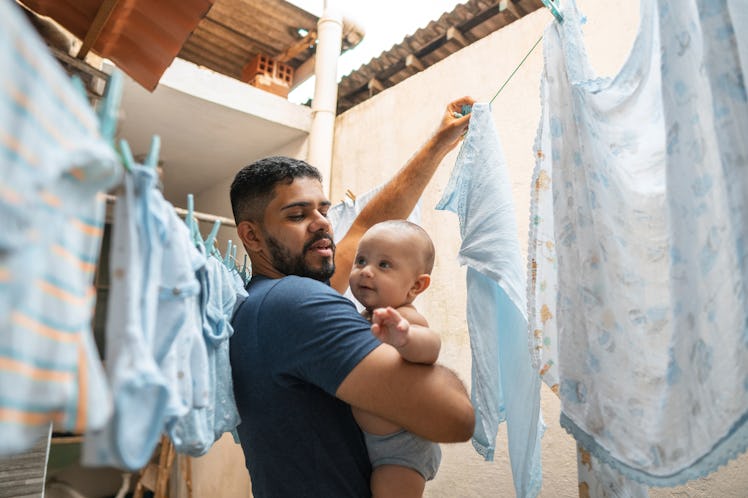3 Easy Steps To Early Potty Training, Inspired By World Cultures
You're playing Call of Doody for awhile.

Many of America’s modern potty training methods come out of the 50s. That’s when the automatic home washing machine became affordable and convenient for most folks. That meant washing diapers and pooped-upon baby clothes was much less of a hassle than it had been so delaying the hassle of teaching your kid to poop in a toilet was totally fine. Though those folks were also popping barbiturates and martinis like Mad Men, so who really knows?
But outside the United States (and Europe, frankly), there are plenty of cultures that tackle potty training comparatively early in a baby’s life. Their techniques are enlightening but are also deeply engrained in specific cultural norms that could be shocking to the typical Westerner. Who, let’s be honest, is easily shocked.
Here are some early-style potty performers from around the world that could possibly influence your own toilet-training techniques.
Bottomless Patience
In some parts of China, the key is a unique baby garment called kai dang ku, which literally translates to “open crotch pants.” These crotchless pants leave a baby’s nethers free to the breeze. And when they gotta go, they simply go. However as parent’s notice the “I gotta go” signals they’ll make a watery hissing sound to help condition the potty response.
Where do they go? Usually a public toilet. If that’s not available they might use a wastebasket or, apparently, a potted plant. At last resort they’ll let them have at it wherever (hopefully pointing the active parts away from innocent bystanders). Don’t worry. The parents do clean up afterward.
There are a host of advantages to the technique, including less waste from diapers and a child’s lack of dependency on something to catch their poop. There’s also less worry about rashes, though one might wonder what happens to those tushes in a cold breeze, which gives new meaning to “freezing your butt off.” The final result? Kids who are toilet trained by their first birthday.
Close Listening
There’s a tribe in Africa that has a similar technique to the Chinese. But while the Chinese practice doesn’t start until around toddlerhood, the Digo people will often begin right at infancy. Here’s how it works:
From the time the kid is born the mother wears the baby close almost constantly. She understands her kid’s pre-potty signals. Prior to the kid letting loose, she will take them outside and let them do their doody while making soft, whispery shushing noises. At some point the baby becomes conditioned to these noises and will only go when they hear them. Kinda like your uncanny ability to have to hit the can when it’s time to wash dishes.
The end result is a super early toilet trained kid who can stay dry by 6 months, compared to your kid who is just figuring out how awesome it is to hit you with a hot golden stream during diaper change time.
Other Elimination Communication
Rural Vietnamese mothers are often held up as the gold standard of early potty training. They too use a conditioned response in order to get their kids to stay dry by 6 months.
Unlike the Digo, Vietnamese mothers don’t wear their kids all the time. That said they are consistently close to their kids and tremendously observant. After they understand their baby’s signs, Vietnamese mothers will whistle prior to the get letting loose. Eventually the child learns not to go until they hear the whistle.
In the United States, mothers desperate to get potty training done early have turned to experts who’ve repackaged these cultural techniques into a method called “elimination communication.” Also the term used for when you and your partner talk about your bowel movements (you do that, right?).
Unfortunately, in most Western cultures mothers don’t have the constant proximity to their kid. So it might take a little bit more time, but the average for people using elimination communication nets out to going diaper free by 12 months. Which isn’t bad.
Just DooDoo It
If you want to give these methods a shot, the steps are pretty simple. But be warned that it does take a ton of concentration on your kid, so forget playing Call Of Duty for a while. Your new game is Call Of Doody.
- Watch for your kids potty signals. These may include facial clues, body positions and going to grab a magazine. It might be easiest if your leave their nethers unclad, just to make sure you’re not broken hearted when you think they pooped but only farted.
- Once you get the signals down, decide on a cue that you’ll use when you see the signs. It could be anything from a sound, to words (“Omaha! Omaha! Hut hut!”) to the potty itself.
- When you see the signal take the baby to the potty and use the cue.
There’s much more detail here if you’re down with an early approach to getting the brown flushed down. Also, it might be good to have the martinis around just in case.
This article was originally published on